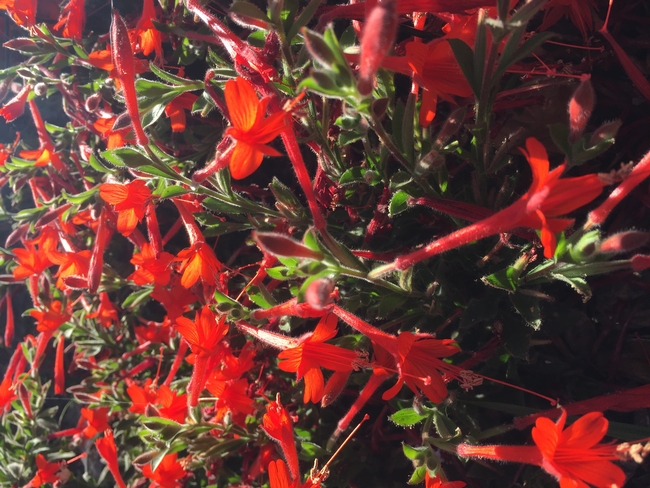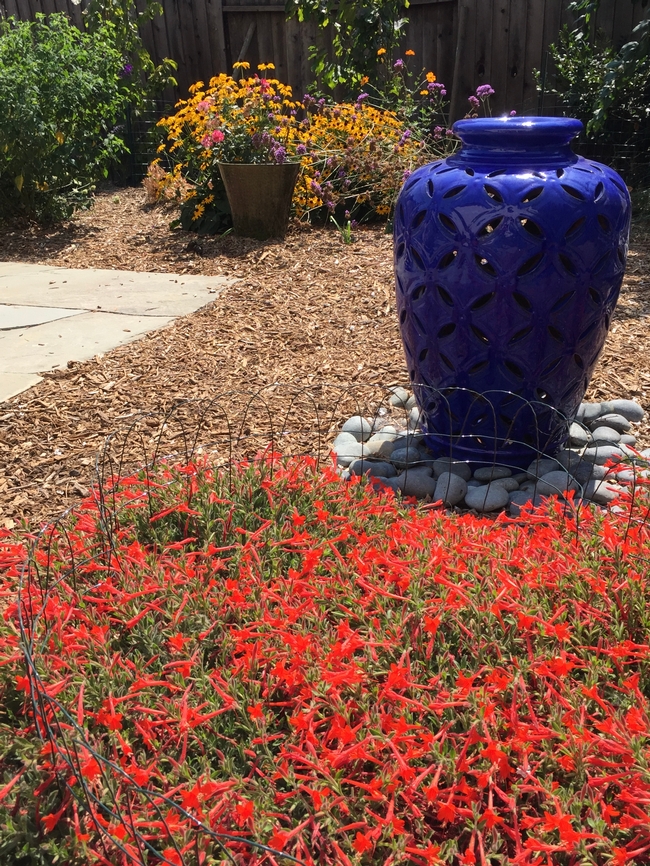- Author: Erin Mahaney
A native groundcover with brilliant, red, trumpet-shaped flowers? Yes, please! When we re-landscaped our backyard a few years ago, the landscaper suggested a California fuchsia, Epilobium 'Everett's Choice,' as a groundcover in a few locations. Unfortunately, the plant didn't thrive in my backyard, but it's worth considering in other locations.
First, what is the scientific name of this plant? It largely depends on the age of the source that you read. The modern scientific name for California fuchsia is Epilobium canum. In that past, however, the plant was placed in the genus Zauschneria, which is still used by horticulturists and others. You will see either name used in nurseries and online.
The variety that of California fuchsia that I planted (‘Everret's Choice') is a low-growing perennial with grey-green, narrow-leaved foliage. Its bright red, 1.5” flowers bloom in late summer through fall and attract hummingbirds. The plant spreads by rhizomes to 6” high and is said to reach about 4-5' wide, although my plants remained a bit smaller. Other varieties of California fuchsia vary in size (up to 3' tall) and color, including bright orange (‘Orange Carpet'), white (‘Summer Snow'), and coral pink (‘Solidarity Pink').
California fuchsia is heat tolerant, but prefers full sun near the coast and part shade in hotter inland areas. The plant is also drought tolerant and can withstand low water in the summer, but it looks better with a bit of summer water. It is semi-deciduous in the winter and, in my yard, goes completely dormant at that time of year. When it starts to look straggly and ratty in late fall or early winter, I cut it back hard to the ground (about 1-2”) and wait for it to regrow. (Taller varieties should be lightly sheared back.) Common uses include as a groundcover, on hillsides for erosion control, edging pathways, spilling out of beds, and as a nectar source.
In many ways, California fuchsia ticked many boxes that interested me, including being a native species, an important nectar source, and drought tolerant. But after the two years, the plant didn't thrive. It simply faded away in one location and disappeared. In the other location, it is alive, but not thriving. I have a few theories. First, once I removed low fencing in one location to protect the plants from the dogs, the dogs stomped all over it. Second, perhaps regular water via drip irrigation is too much summer water for this drought tolerant plant? It's just a theory and I have no evidence at this point. Third, perhaps after the yard filled in, one location became slightly shadier. I still estimate that the location gets 6 hours of sun, so I think this is the weakest theory. Anyway, in the right dog-free location, California fuchsia is worth a try if you are interested in a late-blooming, drought-tolerant California native.






Thanks for your article. My California fuchsias are thriving in downtown Fairfield with quite a lot of shade. They are shaded by a London plane tree so they get winter sun followed by a lot of shade in the summer. I have learned to cut them back as you suggest in the winter and water them occasionally during the summer.
They are very well established, and I’ve spread them throughout the front yard.
Local native plant Society, the Willis Jepson chapter, sells them during its sales.
Loved reading about California fuschias- I will def be on on the lookout to add some to my garden…